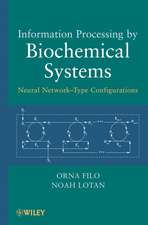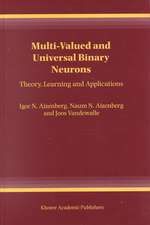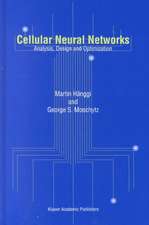Adaptive Modelling, Estimation and Fusion from Data: A Neurofuzzy Approach: Advanced Information Processing
Autor Chris Harris, Xia Hong, Qiang Ganen Limba Engleză Hardback – 13 mai 2002
This book brings together for the first time the complete theory of data-based neurofuzzy modelling and the linguistic attributes of fuzzy logic in a single cohesive mathematical framework. After introducing the basic theory of data-based modelling, new concepts including extended additive and multiplicative submodels are developed and their extensions to state estimation and data fusion are derived. All these algorithms are illustrated with benchmark and real-life examples to demonstrate their efficiency.
Chris Harris and his group have carried out pioneering work which has tied together the fields of neural networks and linguistic rule-based algortihms. This book is aimed at researchers and scientists in time series modeling, empirical data modeling, knowledge discovery, data mining, and data fusion.
| Toate formatele și edițiile | Preț | Express |
|---|---|---|
| Paperback (1) | 647.61 lei 6-8 săpt. | |
| Springer Berlin, Heidelberg – 21 sep 2012 | 647.61 lei 6-8 săpt. | |
| Hardback (1) | 654.21 lei 6-8 săpt. | |
| Springer Berlin, Heidelberg – 13 mai 2002 | 654.21 lei 6-8 săpt. |
Preț: 654.21 lei
Preț vechi: 817.77 lei
-20% Nou
Puncte Express: 981
Preț estimativ în valută:
125.18€ • 130.71$ • 103.37£
125.18€ • 130.71$ • 103.37£
Carte tipărită la comandă
Livrare economică 15-29 aprilie
Preluare comenzi: 021 569.72.76
Specificații
ISBN-13: 9783540426868
ISBN-10: 3540426868
Pagini: 340
Ilustrații: XVI, 323 p.
Dimensiuni: 155 x 235 x 24 mm
Greutate: 0.66 kg
Ediția:2002
Editura: Springer Berlin, Heidelberg
Colecția Springer
Seria Advanced Information Processing
Locul publicării:Berlin, Heidelberg, Germany
ISBN-10: 3540426868
Pagini: 340
Ilustrații: XVI, 323 p.
Dimensiuni: 155 x 235 x 24 mm
Greutate: 0.66 kg
Ediția:2002
Editura: Springer Berlin, Heidelberg
Colecția Springer
Seria Advanced Information Processing
Locul publicării:Berlin, Heidelberg, Germany
Public țintă
ResearchCuprins
1. An introduction to modelling and learning algorithms.- 1.1 Introduction to modelling.- 1.2 Modelling, control and learning algorithms.- 1.3 The learning problem.- 1.4 Book philosophy and contents overview.- 2. Basic concepts of data-based modelling.- 2.1 Introduction.- 2.2 State-space models versus input-output models.- 2.3 Nonlinear modelling by basis function expansion.- 2.4 Model parameter estimation.- 2.5 Model quality.- 2.6 Reproducing kernels and regularisation networks.- 2.7 Model selection methods.- 2.8 An example: time series modelling.- 3. Learning laws for linear-in-the-parameters networks.- 3.1 Introduction to learning.- 3.2 Error or performance surfaces.- 3.3 Batch learning laws.- 3.4 Instantaneous learning laws.- 3.5 Gradient noise and normalised condition numbers.- 3.6 Adaptive learning rates.- 4. Fuzzy and neurofuzzy modelling.- 4.1 Introduction to fuzzy and neurofuzzy systems.- 4.2 Fuzzy systems.- 4.3 Functional mapping and neurofuzzy models.- 4.4 Takagi-Sugeno local neurofuzzy model.- 4.5 Neurofuzzy modelling examples.- 5. Parsimonious neurofuzzy modelling.- 5.1 Iterative construction modelling.- 5.2 Additive neurofuzzy modelling algorithms.- 5.3 Adaptive spline modelling algorithm (ASMOD).- 5.4 Extended additive neurofuzzy models.- 5.5 Hierarchical neurofuzzy models.- 5.6 Regularised neurofuzzy models.- 5.7 Complexity reduction through orthogonal least squares.- 5.8 A-optimality neurofuzzy model construction (NeuDec).- 6. Local neurofuzzy modelling.- 6.1 Introduction.- 6.2 Local orthogonal partitioning algorithms.- 6.3 Operating point dependent neurofuzzy models.- 6.4 State space representations of operating point dependent neurofuzzy models.- 6.5 Mixture of experts modelling.- 6.6 Multi-input-Multi-output (MIMO) modelling via input variable selection.- 7. Delaunay input space partitioning modelling.- 7.1 Introduction.- 7.2 Delaunay triangulation of the input space.- 7.3 Delaunay input space partitioning for locally linear models.- 7.4 The Bézier-Bernstein modelling network.- 8. Neurofuzzy linearisation modelling for nonlinear state estimation.- 8.1 Introduction to linearisation modelling.- 8.2 Neurofuzzy local linearisation and the MASMOD algorithm.- 8.3 A hybrid learning scheme combining MASMOD and EM algorithms for neurofuzzy local linearisation.- 8.4 Neurofuzzy feedback linearisation (NFFL).- 8.5 Formulation of neurofuzzy state estimators.- 8.6 An example of nonlinear trajectory estimation.- 9. Multisensor data fusion using Kaiman filters based on neurofuzzy linearisation.- 9.1 Introduction.- 9.2 Measurement fusion.- 9.3 State-vector fusion.- 9.4 Hierarchical multisensor data fusion — trade-off between centralised and decentralised Architectures.- 9.5 Simulation examples.- 10. Support vector neurofuzzy models.- 10.1 Introduction.- 10.2 Support vector machines.- 10.3 Support vector regression.- 10.4 Support vector neurofuzzy networks.- 10.5 SUPANOVA.- 10.6 A comparison among neural network models.- 10.7 Conclusions.- References.
Recenzii
From the reviews:
"This is an account of a major development by a research group in Southampton University on the extension of adaptive techniques to nonlinear and nonstationary environments. … There seems to be no doubt that this well-presented book is indispensable for anyone concerned with difficult nonlinear problems of control." (Alex M. Andrew, Robotica, Vol. 22, 2004)
"This book brings together for the first time the complete theory of data-based neurofuzzy modelling and the linguistic attributes of fuzzy logic in a single cohesive mathematical framework. … This book is aimed at researchers and scientists in time series modelling, empirical data modelling, knowledge discovery, data mining, and data fusion." (Nikolay Yakovlevich Tikhonenko, Zentralblatt MATH, Vol. 1005, 2003)
"This is an account of a major development by a research group in Southampton University on the extension of adaptive techniques to nonlinear and nonstationary environments. … There seems to be no doubt that this well-presented book is indispensable for anyone concerned with difficult nonlinear problems of control." (Alex M. Andrew, Robotica, Vol. 22, 2004)
"This book brings together for the first time the complete theory of data-based neurofuzzy modelling and the linguistic attributes of fuzzy logic in a single cohesive mathematical framework. … This book is aimed at researchers and scientists in time series modelling, empirical data modelling, knowledge discovery, data mining, and data fusion." (Nikolay Yakovlevich Tikhonenko, Zentralblatt MATH, Vol. 1005, 2003)
Textul de pe ultima copertă
In a world of almost permanent and rapidly increasing electronic data availability, techniques of filtering, compressing, and interpreting this data to transform it into valuable and easily comprehensible information is of utmost importance. One key topic in this area is the capability to deduce future system behavior from a given data input. This book brings together for the first time the complete theory of data-based neurofuzzy modelling and the linguistic attributes of fuzzy logic in a single cohesive mathematical framework. After introducing the basic theory of data-based modelling, new concepts including extended additive and multiplicative submodels are developed and their extensions to state estimation and data fusion are derived. All these algorithms are illustrated with benchmark and real-life examples to demonstrate their efficiency. Chris Harris and his group have carried out pioneering work which has tied together the fields of neural networks and linguistic rule-based algortihms. This book is aimed at researchers and scientists in time series modeling, empirical data modeling, knowledge discovery, data mining, and data fusion.
Caracteristici
First book to present a mathematical framework for neurofuzzy modeling using generalised linear neural networks Focus on practically applicable algorithms for data based modeling and time series problems as market forecasting Lots of benchmark examples to show the algorithms' efficiencies Includes supplementary material: sn.pub/extras































